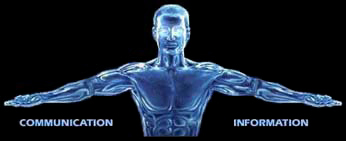 
19
|
|
Introduction
We encourage you to verify the source images for yourself, rather than just simply accept the facts that are presented here.
Exact details of the used image templates can be found here.
Some reports on this website are based on previous ones. So it is extremely important to read the reports in chronological order.
Details can turn up that were probably already been analyzed in detail. If you are new here and you directly start reading the
recent reports without prior knowledge, then it could happen, that the required context is not recognizable.
You do yourself and us a favor when you first start with the oldest reports.
This report makes reference to structure anomalies, that have been discovered in Aram Chaos. We recommend that you also
review the previous reports, if you have not read them yet.
The following documents are relevant:
"Half Face" Syndrome
Worldwide curious people frequently comb through the public image archives of NASA, in order to take a look to the
recordings that were sent to us by the Mars rovers and the orbital probes. Some do this for purely scientific interest,
others from the fascination to see pictures of an alien world. Others are trying to find specifically structural
anomalies that can not be of natural origin.
It's an interesting phenomenon that faces can be dicoveres again and again on these image recordings.
They appear in all shapes and sizes. Whether enormously large as the famous Face on Mars in the Cydonia
region or tiny, with dimensions of only a few centimeters. It is often strange-looking faces, some of
which have human-looking lineaments, or also some other ones that come along with an animalistic look.
But one thing is very striking - a very large proportion of this supposed stone faces only show the half
of a face. Exemplary is an image example, taken by the rover Curiosity on SOL 528 which has quickly spread
to pertinent websites. This special discovery is presented (with altered color calibration) in the following way:
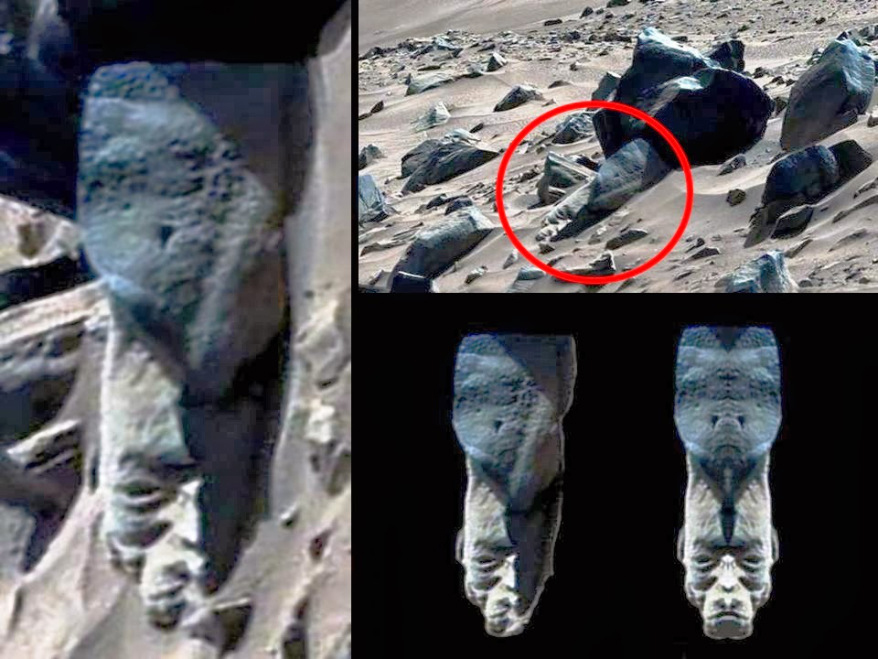
Click to enlarge the image
Can one ever doubt by looking on these images that the shown structure is not artificial origin?
The truth is, unfortunately, that details and views are predefined and they do not exist in the shown form.
The artificially created frontal view is based on a simple mirroring and contains on closer inspection several
inconsistencies (original images and source information are available on the
template page ).
Through mirroring additional information values are created out of nowhere and they artificially enhance
the impression of a face. This generally raise the question whether mirroring represent a legitimate method
in professional image examinations. ).
Through mirroring additional information values are created out of nowhere and they artificially enhance
the impression of a face. This generally raise the question whether mirroring represent a legitimate method
in professional image examinations.
This may serve in no case as evidence, because aspects are anticipated that do not exist de facto.
Experience shows that especially reflection processes favor to a large extent the risk of misinterpretation.
Due to the fact that a perfect symmetry is generated, the observer has subconsciously a sense of artificiality.
This is done regardless of what is present as motive. By mirroring any chaotic pattern loses its natural character.
The fact that this view represents only a hypothetical model and also needs to be considered so, is here forgotten quickly.
Instead, people focus on the reflection result and are quite convinced of its artificiality due to the inevitably present
perfect symmetry.
However, "half faces" represent a special case that needs to be considered particularly critical.
In contrast to chaotic patterns the interpretation result is particularly strongly influenced
by mirroring of a supposed half face.
In this particular case the impression of an artificial structure does not increase by twice
but because of human perception psyche by a factor which lies beyond.
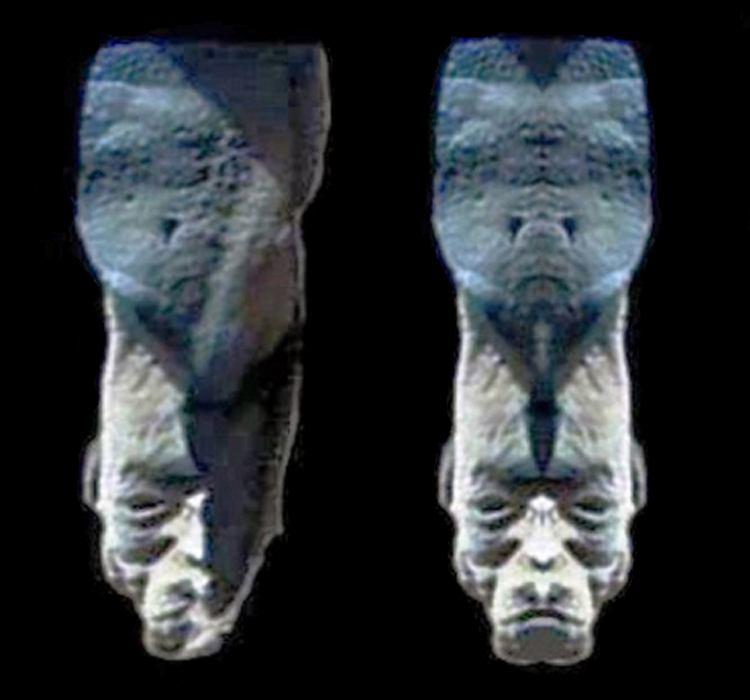
Click to enlarge the image
Users of such procedures want give the viewer the impression of how the supposed face would look completely and
what amazing prone arrangement of the anatomical features are present. Taken by itself, the use of this
method is quite understandable. However, it completely left out, that examples can be repeatedly found in nature for
structures having similarities with human heads. In contrast, the probability of detection of a complete
head-head structure (with all important anatomical features in the correct positions and continuous symmetry properties),
is very low. Thus, it is not at all surprising from the statistical probability, almost exclusively
anomalies has been discovered that just show lateral profile views or faces, which seem frontally looking, but then again
are displaying just the half of a face.
In fact, in this example, we can only recognize the half of a face. But this half appears at first glance to have
many anatomical features, as they are known by human beings. However, this impression must be put into perspective.
This becomes clear when the alleged facial half is viewed from a different angle.
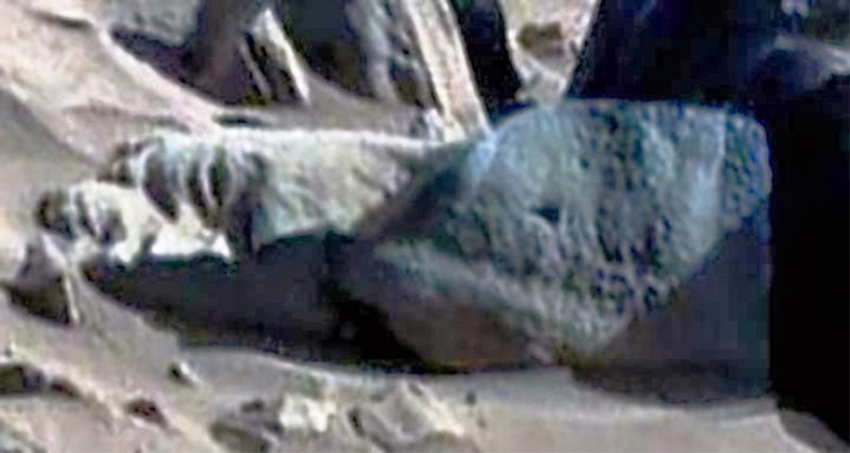
Click to enlarge the image
The new vertical aligned view makes it clear that the detail that has been interpreted as ear, is in fact not attached
at the stone block. It is a underlying ledge. In the vertical view the impression of a "face" is not as obvious as in
the horizontally oriented view. Thus, the viewing angle is an important aspect in elementary psychology of perception.
Fatally, the suppression of the background as a black surface solidifies the impression of an adjacent ear.
Important information are cut off that could have helped, to avoid optical misinterpretations.
How many details around the structure may be hidden, is a purely subjective matter. This assessment is definitely not
shared by everybody. Considering the area of the alleged ear in the original image, it is striking that
the ear has no real connection to the head. The template from the Internet, however, reveal further details that goes
along with a very rigorous hide of details.
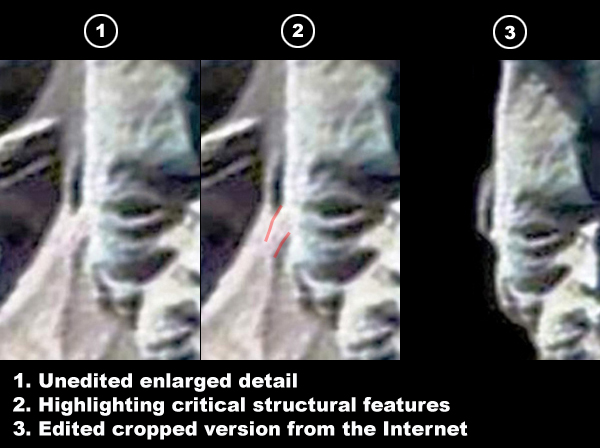
Click to enlarge the image
By reproducing this process, in order extract the head-like structure from the background, one will notice
that below (or rather to the left) of suspected ear a stone edge pushes in between. But by hiding of this edge,
the impression of a suspected head half is significantly strengthened. Disturbing details have been conveniently
cut off, which would militate against the reasonable arrangement of anatomical features.
Another momentous aspect is related to the implementation of mirroring. In addition to the face a further detail is
given, that is to indicate a meaningful design. This detail is to be some kind of headgear. It is the attempt
of an assignment to a feature that actually does not appear plausible. This headgear is
unnaturally high positioned over the face and also has a very distinctive design.
Of course, a relevant point of criticism would be the meaningfulness of such a headgear. However, in return,
it could be argued that the special extraneousness must be treated as a feature of an extraterrestrial cultural.
On this detail advocates and counter spokesman would chafe against each other without consent.
However, it is not necessary to deal with these options. In contrast to the face area, from which one can see only
half clearly, the part which is declared as headgear, is almost completely visible. It can be deduced pretty good
that no symmetrical structure is present. The mirroring result simply hides existing structures and idealized the
impression of a stone sculpture with perfect symmetry. It also seems not to be plausible that weathering and
broken parts have affected the supposed symmetry, because some larger edges protrudes in the opposite area.
In addition, also inconsistencies in the facial plane can be discovered. The still well identifiable part of the
nose extends with its outlines over the imaginary center line. But the rigorous mirroring hides this inconsistency.
It is important to make this point clear: The mirroring view, showing the clearly identifiable symmetric face, does
not to comply with the facts.
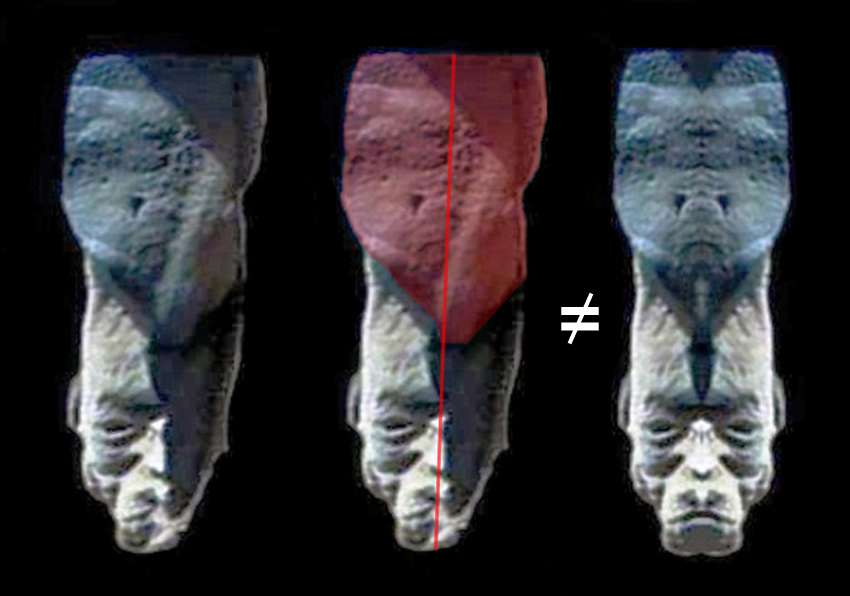
Click to enlarge the image
Despite the inadequate deviations, as an attempt the mirroring was adjusted based on the "ideal" looking left side.
By doing this another extremely unpleasant detail came to light.
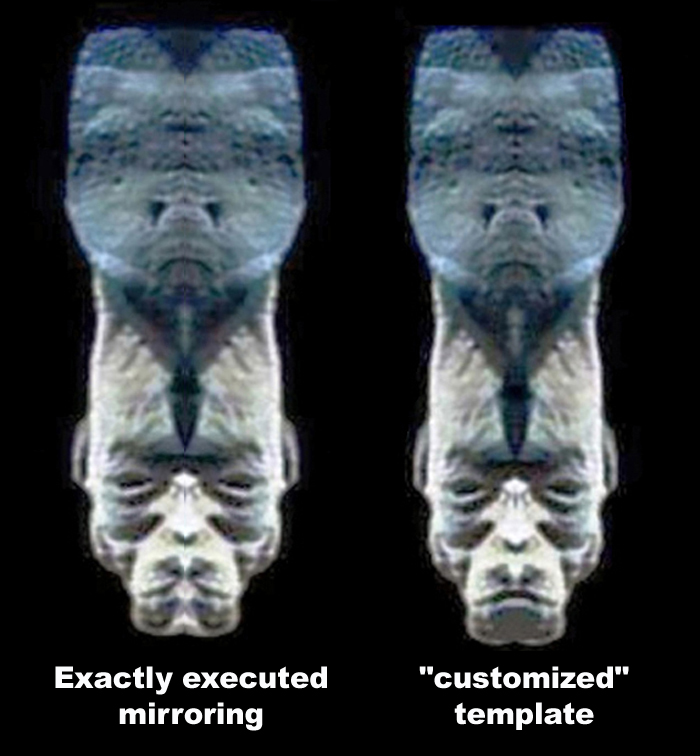
Click to enlarge the image
The reproduced mirroring view does not correspond exactly to the image template that is touted as proof of a stone face.
Under no circumstances the result can be reproduced in the same way. Even a tapered centerline causes no improvement.
It can be see clearly in the mouth area. A solid line was drawn in order to create the
impression of a mouth. In addition, the chin was darkened uniformly. Likewise, the entire structure has been
slightly diminished probably because the face seemed too broad and brawny. However, this has nothing to do with a
simple mirroring. Essential features were trimmed. A very sobering result. It is up to the
viewer, how to evaluate such clandestine changes.
Apart from unacceptable changes in the image file, it should be noted that with the use of a simple mirroring
elementary inconsistencies were comfortably hidden. The detailed analysis is intended to highlight what
disadvantages such mirroring approaches have and that the risk of misinterpretation is very large. The result of the
mirroring effect seems uncommonly convincingly for a casual observer. The consequence of this can only be to be extremely
careful with interpretations, if somewhere a (half) face is detected again. Just as it is presented in this case study,
it is a deception at several levels.
Here too it is again the case that the structural anomaly represents a single phenomenon that is placed in the midst of a
completely unassuming environment. There are no signs of further structural abnormalities within the underlying image
that may allow further possible speculative approaches (without getting lost too much in chaotic patterns and to run the
risk of recognizing faces - Pareidolia Effect). This need not be a criterion for exclusion, but it illustrates
once more that the only significant starting point for scrutiny in terms of real existing symmetry turns out to be a
complete flop.
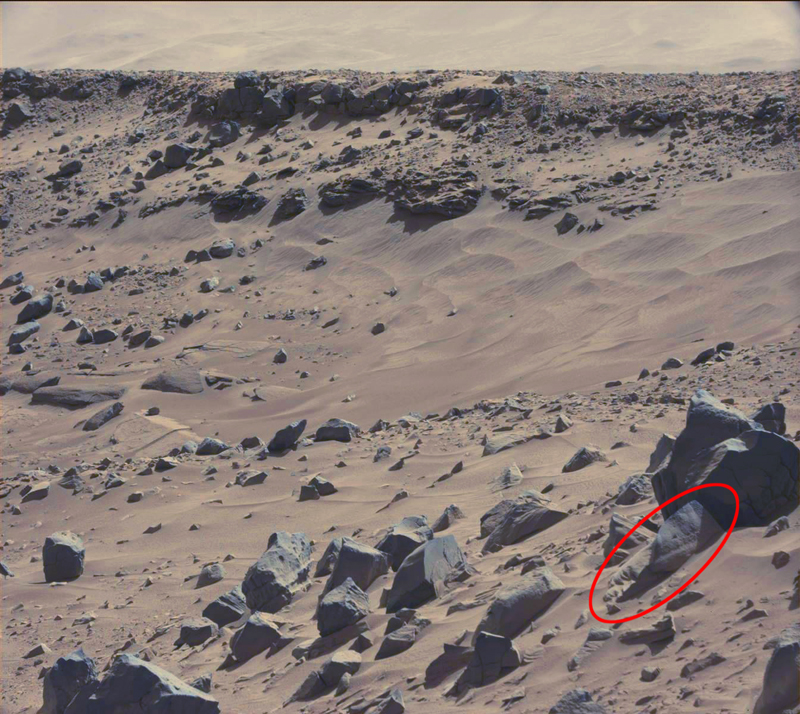
Click to enlarge the image
Impression of artificiality - blocky artifacts
A photo is a depiction of reality. The situation nowadays is no different than it was then in the days of analog imaging.
We continue to produce depictions of reality, using digital cameras to store images in the form of binary data packets.
By default, this is done in the so-called JPG image format. Behind JPG stands an image compression method that was tuned
to store image information so that they consume as little space as possible. This is accomplished by data compression.
In contrast to the compression of e.g. executable files, where it is essential that from the compressed data the original
data can be completely restired, it is not absolutely necessary to get all the information values for image, video, and
audio files. This is called lossy compression.
The loss on the visual image is minimal for the human perception. In most cases, it is not perceived. This was also the
objective in the development of the JPG format. The overall impression should not be compromised. The problem arises
only if you want to look at small areas in detail and by enlarging these areas at extremely high grades.
Depending on the quality level of the performed JPEG compression, it makes beyond a certain point no sense to magnify
finest structural details to make them more recognizable. In extreme enlargements it will create a falsified representation of reality.
This condition is relativised when the magnification factor is withdrawn. This is the nature of lossy image compression.
It either hardly seems familiar or it is simply disregarded that within these small areas display errors and patterns
are being created that no longer correspond to the real environment.
This representation errors are hardly perceptible on the overall picture, but the closer one zooms in on details,
the stronger they occur in the foreground. There are a series of interference phenomena that can occur simultaneously,
beside the emblematic blocky artifacts. Other disturbing effects
 for example are so-called ringing or banding effects or
the Gibbs phenomenon. If especially these image artifacts are used as evidence for the existence of an allegedly artificial
structure, it may not be surprising if one is not taken seriously by professional image analysts. Examples such as the
following boxlike object are being discovered again and again.
for example are so-called ringing or banding effects or
the Gibbs phenomenon. If especially these image artifacts are used as evidence for the existence of an allegedly artificial
structure, it may not be surprising if one is not taken seriously by professional image analysts. Examples such as the
following boxlike object are being discovered again and again.
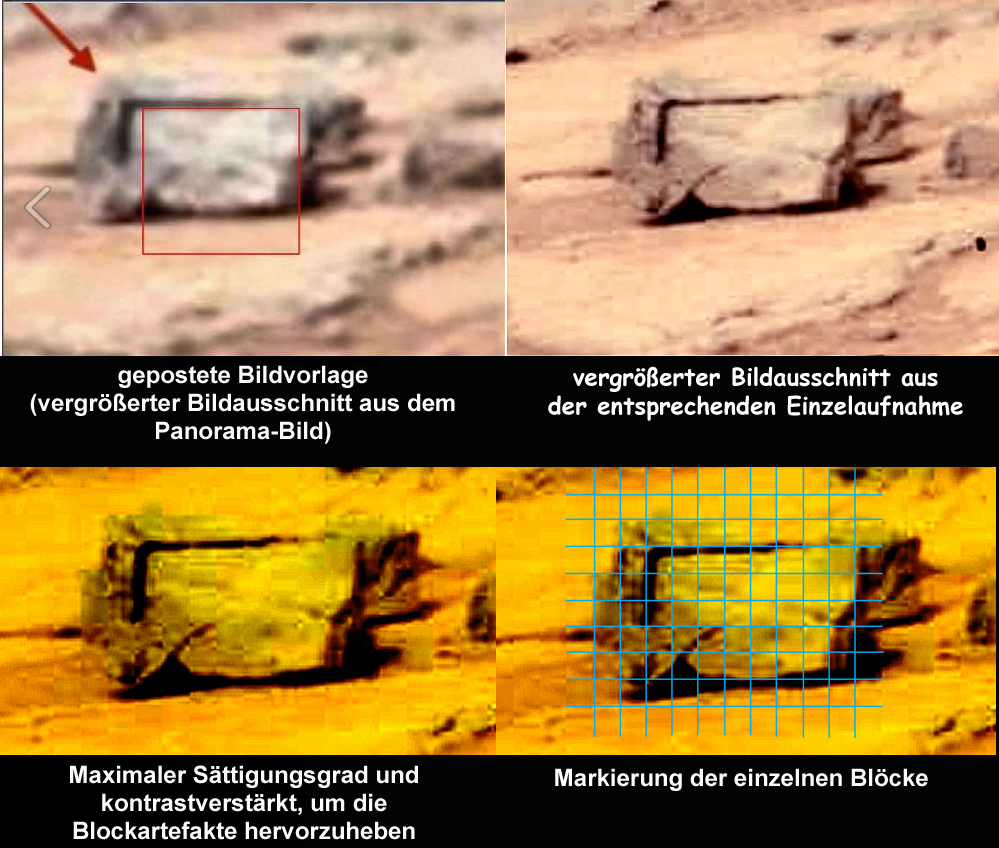
Click to enlarge the image
With regard to the images of the Mars Rovers, it is always problematic to consider objects in detail, which
are very small and lying farther away. In conjunction with image artifacts, the result is a completely inadequate
basis for image analysis. The example shown here is a classic example, of forcing a proof of artificiality.
According to the probabilities in the variety of the present chaotic shaped boulders there are always a few small
rock ledges running exactly along the straight border lines of quantization blocks. The overlay causes some edges to
appear razor-sharp and straight. Since the object also fulfills all aspects that have been mentioned as problematic,
a box-shaped outline is not an extraordinary phenomenon.
Another cardinal mistake is to take a so-called GigaPan image instead of the original image shot. The GigaPan image is
a composite of several individual images and reworked panorama image. Such GigaPan may comprise either stitching errors
(offset errors to the converging seam areas) or it has been aligned visually by calculation routines,
which may not be useful for a detailed analysis, as is also lost the integrity of the original image.
Apart from this a resultant panoramic image has run at least one or multiple compression cycles, whereby fine
structures become even more blurred. GigaPan images are usefull to receive a general orientation, but they are
not an option for detailed image analysis. It should be obvious in advance, why just the "Raw Images", respectively
the original image shots should be used. Nevertheless, you will find countless reported findings on images
that has been taken from such GigaPans.
Combination of half face, blocky artifacts and extreme magnification
It is the view of a demonic grimace. A nearly circular eye, including pupil and notable features of large teeth.
Another impressive image example in which one would not initially accept that nature could create such a bizarre object.
The anatomical features of an eye,a mouth (including upper and lower teeth), and the beginnings of a nose appear to be
sensibly arranged.
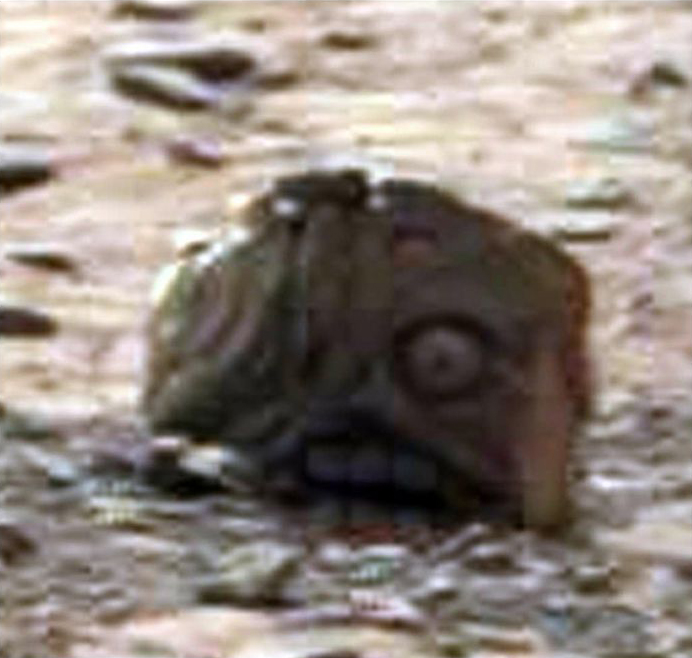
Click to enlarge the image
The picture shows a highly magnified image section that was created by the Curiosity Rover on its 184th day on Mars (SOL 184)
near the Yellowknife Bay within the Gale crater. The corresponding original recording and the reference to the official source
image is listed on the template page
template page  containing all images that have been used for this analysis report.
containing all images that have been used for this analysis report.
A detailed analysis shows that the edges of quantization blocks extend precisely at the same point at which the "row of teeth"
is visible and dark lines divide the individual teeth.

Click to enlarge the image
These lines features are not limited to the putative tooth row, but run through the entire image.
However, for an observer just the teeth seem to emerge very clear. This effect is based on the way how the human brain,
try to complete diffuse incomplete perceptions and to set them in connection with known patterns. In this example, an
association with individual teeth is quickly established. Following the line course that form the quantization blocks,
one realizes that elsewhere too is a clear contrast change that can be seen along these lines. The changing surface
texture of the stone blocks let the lines more or less easily discernible at different points.
How can you be sure that only a natural stone block is present and not yet the fragments of carved stone head?
The answer is that you can't be fully secure by just looking at a single image. There is a certain degree of possibility
that we are looking at carved stone head, but the assessment of artificiality should not be pinned down on few features
that can be well explained as coincidence or as side effect of lossy image compression. These things must be considered
soberly. However, in this case here the suspected teeth fully interacts with the features of blocky image artifacts
(see markings of the quantization artifacts).
It is another typical example that we see just the half of a face again.
Thus a further important reference point like symmetry property is omitted, with which one could argue against the likelihood
of a natural phenomenon. As fascinating as this stone block may look at first glance, so numerous are explanations in favor
of a natural origin. This object is of very obvious reasons (half face phenomenon, blocking artifacts, extreme magnification)
vulnerable for misinterpretations. Unfortunately, image artifacts are being strengthened by the additionly performed
contrast enhancement. In simultaneous interaction of these unfavorable factors, the (usually) helpful image editing
method of contrast enhancement results in a misstep. To that extent, such example can never be taken as definitive evidence.
If comparison shots are missing, then there is no basis for an objective evaluation.
However, there is another image showing this structure. According to the time code, it one onw was created just 46 seconds
earlier than the other image we have been looking at. (The original image files are listed on our
template page  )
)
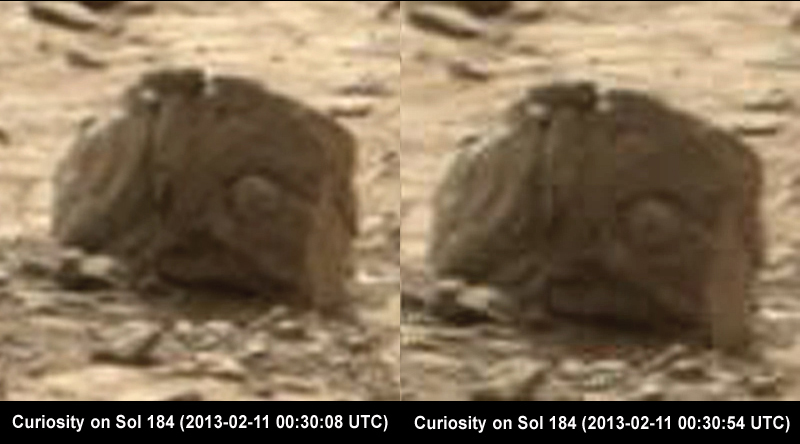
Click to enlarge the image
This image template contains far less block artifacts and thus provides better conditions for detailed
investigations. This comparison image can now confirm all assumptions we made above. There is no row of teeth and also the
alleged eye proves to be clearly irregular. The salient features have emerged as a result of more pronounced blocky artifacts
by the lossy compression. Marking the edges of the blocky image artifacts allows to understand why the impression of
alleged facial characteristics are present here.
Why has this older and actually better image not been taken up by the anomaly hunters? Each additional comparative
image template provide extremely important clues. Is it still an objective analysis when such important information
are omitted? It has been shown repeatedly that high anticipations lead to selective perception and unilateral interpretation.
The full range is being served that repeatedly lead to the most fatal misinterpretation. Distinctive blocking
artifacts, completely exaggerated magnification (in relation to the total image shot) and again the half of a face
that occurs as a single phenomenon in an unassuming environment. Presented in a greatly enlarged and tight framing
it necessarily looks extremely unnatural and it is therefore not surprising that images like these can virally make their
rounds in the Internet. But this is a completely anticipated effect.
Unfortunately it's completely nonsensical to cite especially these kind of structure anomalies as evidence for artificiality. It is in
Undiscerning viewers believe to see very clearly the fragment of a sculpture. Methodological analysis approaches and the
comparison of appropriate images, however, can exactly explain why these structures in such a deceptive manner.
Methodical image analysis
The majority of anomaly discoveries that have been published and distributed in the Internet are based on JPEG images,
containing distinct block artifacts and which are partly enlarged to a factor of over 800 percent. Any intentions on ascertaining the
truth are reduced to absurdity by using such methods and will be unavoidable to become a victim of the ever-present Pareidolia effect.
As long as people will continues acting in this way, there will always be new wacky discoveries that stand without any logical
connection to the environment. This becomes evident in the contrasting juxtaposition with other images shots showing the location
from a different angle and/or at another time. But these necessary comparison images do not exist in most cases, or they are omitted
negligently or consciously. Nevertheless, the claim of evidence is often being set on a single image.
Due to many unfavorable conditions it isn't possible to make any binding statements. There is just enough room for assumptions.
But even in such cases it is neccessary to substantiate what reasons justify such an assumption. The lack of understanding on how
digital image processing works will lead inevitably to fantasy products. Pertinent interpretations can completely miss the actual
true conditions. Regardless of whether one is convinced of the existence of extraterrestrial structures on Mars or not, comprehensive
technical background knowledge is required for serious investigations.
The practical benefit of uncoordinated wild rummage in image databases and free association games performed unrestrained
to virtually all conspicuous structures can be gauged from examples as they have been shown in this report.
Apart from the problem of the so-called evidence-dilemmas (namely the distinct possibility that compromising evidence for artificial
objects are filtered out and only defused recordings are being made publicly available - which in turn is not provable), each one
have to ask the question, what results can be expected at all. The hope that the simple web surfer is able to find the ultimate proof
just by browsing through image databases an forcing the society upside down overnight, is rather naive. That is never going to happen.
Answers have to be worked out in a different way.
A methodical approach can reduce the susceptibility of drawing false conclusions.
It can also help to recognize discoveries from other sources as faulty (or even as manipulated).
The following points must be examined in detail:
Is the anomalous structure just a single phenomenon or are further images present that show the same eye-catching details and allow a comparison?
Do the images contain distinctive image artifacts and could they possibly create the impression of artificiality?
Had the image been enlarged and is the magnification factor at a reasonable level?
Only if these questions can be answered in favor of the discovered structure anomaly, only then a secondary examination is useful
and allows at the end more binding statements that could contribute to finding the truth.
|
|
